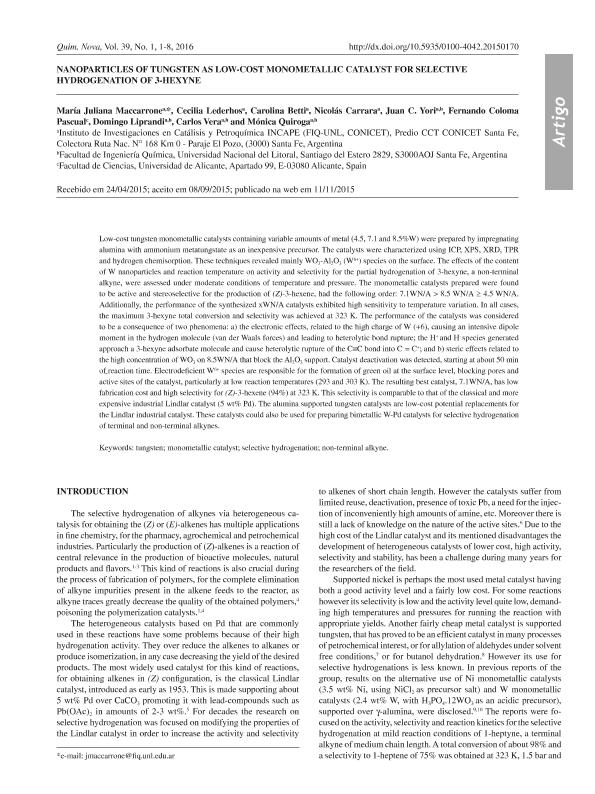Mostrar el registro sencillo del ítem
dc.contributor.author
Maccarrone, María Juliana

dc.contributor.author
Lederhos, Cecilia Rosa

dc.contributor.author
Betti, Carolina Paola

dc.contributor.author
Carrara, Nicolás Ricardo

dc.contributor.author
Yori, Juan Carlos

dc.contributor.author
Coloma Pascual, Fernando
dc.contributor.author
Liprandi, Domingo Antonio

dc.contributor.author
Vera, Carlos Roman

dc.contributor.author
Quiroga, Monica Esther

dc.date.available
2018-02-21T20:28:14Z
dc.date.issued
2016-01
dc.identifier.citation
Maccarrone, María Juliana; Lederhos, Cecilia Rosa; Betti, Carolina Paola; Carrara, Nicolás Ricardo; Yori, Juan Carlos; et al.; Nanoparticles of tungsten as low-cost monometallic catalyst for selective hydrogenation of 3-hexyne; Sociedade Brasileira de Química; Química Nova; 39; 1; 1-2016; 1-8
dc.identifier.issn
0100-4042
dc.identifier.uri
http://hdl.handle.net/11336/36921
dc.description.abstract
Low-cost tungsten monometallic catalysts containing variable amounts of metal (4.5, 7.1 and 8.5%W) were prepared by impregnating alumina with ammonium metatungstate as an inexpensive precursor. The catalysts were characterized using ICP, XPS, XRD, TPR and hydrogen chemisorption. These techniques revealed mainly WO3-Al2O3 (W6+) species on the surface. The effects of the content of W nanoparticles and reaction temperature on activity and selectivity for the partial hydrogenation of 3-hexyne, a non-terminal alkyne, were assessed under moderate conditions of temperature and pressure. The monometallic catalysts prepared were found to be active and stereoselective for the production of (Z )-3-hexene, had the following order: 7.1WN/A > 8.5 WN/A ≥ 4.5 WN/A. Additionally, the performance of the synthesized xWN/A catalysts exhibited high sensitivity to temperature variation. In all cases, the maximum 3-hexyne total conversion and selectivity was achieved at 323 K. The performance of the catalysts was considered to be a consequence of two phenomena: a) the electronic effects, related to the high charge of W (+6), causing an intensive dipole moment in the hydrogen molecule (van der Waals forces) and leading to heterolytic bond rupture; the H+ and H- species generated approach a 3-hexyne adsorbate molecule and cause heterolytic rupture of the C≡C bond into C- = C+; and b) steric effects related to the high concentration of WO3 on 8.5WN/A that block the Al2O3 support. Catalyst deactivation was detected, starting at about 50 min of reaction time. Electrodeficient W6+ species are responsible for the formation of green oil at the surface level, blocking pores and active sites of the catalyst, particularly at low reaction temperatures (293 and 303 K). The resulting best catalyst, 7.1WN/A, has low fabrication cost and high selectivity for (Z )-3-hexene (94%) at 323 K. This selectivity is comparable to that of the classical and more expensive industrial Lindlar catalyst (5 wt% Pd). The alumina supported tungsten catalysts are low-cost potential replacements for the Lindlar industrial catalyst. These catalysts could also be used for preparing bimetallic W-Pd catalysts for selective hydrogenation of terminal and non-terminal alkynes.
dc.format
application/pdf
dc.language.iso
eng
dc.publisher
Sociedade Brasileira de Química

dc.rights
info:eu-repo/semantics/openAccess
dc.rights.uri
https://creativecommons.org/licenses/by-nc-sa/2.5/ar/
dc.subject
Tungsten
dc.subject
Monometallic Catalyst
dc.subject
Selective Hydrogenation
dc.subject
Non-Terminal Alkyne
dc.title
Nanoparticles of tungsten as low-cost monometallic catalyst for selective hydrogenation of 3-hexyne
dc.type
info:eu-repo/semantics/article
dc.type
info:ar-repo/semantics/artículo
dc.type
info:eu-repo/semantics/publishedVersion
dc.date.updated
2018-01-18T14:41:08Z
dc.identifier.eissn
1678-7064
dc.journal.volume
39
dc.journal.number
1
dc.journal.pagination
1-8
dc.journal.pais
Brasil

dc.journal.ciudad
San Pablo
dc.description.fil
Fil: Maccarrone, María Juliana. Consejo Nacional de Investigaciones Científicas y Técnicas. Centro Científico Tecnológico Conicet - Santa Fe. Instituto de Investigaciones en Catálisis y Petroquímica ; Argentina
dc.description.fil
Fil: Lederhos, Cecilia Rosa. Consejo Nacional de Investigaciones Científicas y Técnicas. Centro Científico Tecnológico Conicet - Santa Fe. Instituto de Investigaciones en Catálisis y Petroquímica ; Argentina
dc.description.fil
Fil: Betti, Carolina Paola. Consejo Nacional de Investigaciones Científicas y Técnicas. Centro Científico Tecnológico Conicet - Santa Fe. Instituto de Investigaciones en Catálisis y Petroquímica ; Argentina
dc.description.fil
Fil: Carrara, Nicolás Ricardo. Consejo Nacional de Investigaciones Científicas y Técnicas. Centro Científico Tecnológico Conicet - Santa Fe. Instituto de Investigaciones en Catálisis y Petroquímica ; Argentina
dc.description.fil
Fil: Yori, Juan Carlos. Consejo Nacional de Investigaciones Científicas y Técnicas. Centro Científico Tecnológico Conicet - Santa Fe. Instituto de Investigaciones en Catálisis y Petroquímica ; Argentina
dc.description.fil
Fil: Coloma Pascual, Fernando. Universidad de Alicante. Facultad de Ciencias; España
dc.description.fil
Fil: Liprandi, Domingo Antonio. Consejo Nacional de Investigaciones Científicas y Técnicas. Centro Científico Tecnológico Conicet - Santa Fe. Instituto de Investigaciones en Catálisis y Petroquímica ; Argentina
dc.description.fil
Fil: Vera, Carlos Roman. Consejo Nacional de Investigaciones Científicas y Técnicas. Centro Científico Tecnológico Conicet - Santa Fe. Instituto de Investigaciones en Catálisis y Petroquímica ; Argentina
dc.description.fil
Fil: Quiroga, Monica Esther. Consejo Nacional de Investigaciones Científicas y Técnicas. Centro Científico Tecnológico Conicet - Santa Fe. Instituto de Investigaciones en Catálisis y Petroquímica ; Argentina
dc.journal.title
Química Nova

dc.relation.alternativeid
info:eu-repo/semantics/altIdentifier/doi/http://dx.doi.org/10.5935/0100-4042.20150170
dc.relation.alternativeid
info:eu-repo/semantics/altIdentifier/url/http://ref.scielo.org/8ytc39
Archivos asociados
